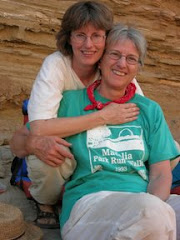 |
| Lima, Peru's underground catacomb human bone pits |
We’ve made the rounds of several museums and historic sites including the Church of San Francisco built in 1674. This church is famous for its vast underground catacombs containing the bones of 75,000 people.
In this first cemetery of colonial Lima, bodies were laid in pits and covered with quicklime to hasten decomposition. We walked past boxes with femurs organized in herringbone patterns and deep pits with thousands of bones and skulls artistically arranged. Hundreds of skulls are stacked on shelves cut into the earthen walls.
Another museum in Lima contains twenty-five-hundred-year-old mummies from the pre-Inca era. Given the arid Peruvian climate, mummifying was a perfect way to preserve bodies. Both the catacombs and the mummies are precursors to the modern concept of green funerals. (See our earlier blog, "Green Funerals 101.")
All this put us in a receptive frame of mind for an article we discovered in London’s prestigious newspaper, The Guardian. “What Really Happens When You Die?” features interviews with six professionals who handle corpses. They detail the procedures of autopsying, embalming, burying, and cremating a body--the modern ways of death.
 |
| Resomation unit, Whole Body Donor Program, Mayo Clinic, Rochester, MN |
I had a long talk with Dean Fisher at the Mayo Clinic in Rochester, MN. A strong proponent of resomation, he seemed quite proud of his unit . This method of final disposition is not used outside of Mayo's whole body donor program and some veterinary medicine schools. Fisher did not seem optimistic that resomation would be widely available any time soon, noting that “There are only a few resomation chambers in operation in the world.”
Nevertheless, this environmentally-friendly method of dealing with our bodies might be the wave of the future. For more information about this greener alternative to cremation and burial, visit Resomation Ltd.
Hundreds of years from now, tourists may pay to tour American museums formerly known as cemeteries!


